

|
|
|
|
|
|
|
|
|
|
Building a Segmented Drum |
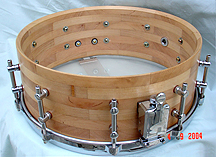
Drum by guguinet |

Drum by guguinet |
|
This is not a very common method of building although it makes a perfectly fine shell. They are built almost exclusively by custom builders. They are similar to staves in a lot of ways - in fact, they can be thought of as many rings of smaller staves. The advantages and disadvantages are also somewhat similar to staves. Basic description: Small horizontal pieces are cut with beveled edges to form a circle which is glued and clamped. Several rings are made this way. The rings are then placed on top of each other (with joints offset) and glued and clamped. When the glue is dry the outside and inside are lathed or routed to achieve a smooth, round shell. Pluses: Many exotic wood varieties are available. Can be made from smaller pieces of wood than stave method. Grain is horizontal which some believe doesn't produce the best tone, although this is highly debated. Uses less glue than ply but more than staves (because it has smaller pieces). It's easy to make thick shells. Not likely to go out of round because the wood is not being stressed into shape. Ideal for making mixed wood shells. Individual segments can be cut with a miter saw (unlike staves) because they are not very tall. Minuses: Wood is more costly than ply. Requires more special tools than the ply method. Not a good method for making a thinner shell. More time consuming to make the segments (compared to staves). Biggest complaint seems to be how they look - kind of like hardwood floors. Special tools required: Router or table saw or miter saw to bevel the staves (router also needed for bearing edges). Lathe needed for rounding the edges of the staves. (Or special jig can be made with a router - see Koko's Stave Drum Without a Lathe sticky post in the General Building section of the Drum Shed forum.) DISCUSSIONS FROM THE DRUMSHED FORUM hippybaker: How do you guys do segment shells? Is it glued in 2 steps? My plan was to glue the rings up, and then stack them and glue them on top of one another after they dry.. Is that correct? J.Richard: Yep. michael watkins: A thickness sander or hand plane comes in handy to level the segments so they stack nicely- necessary for a good fitting glue joint. This was my biggest issue to overcome with segment hoops and the few segment shells I did. And remember to check the perpendicularity of your chop saw blade since you'll be dealing with butt joints too. Z1QR20: Segment construction is like stave, but less the number of sections for each "layer". It's like taking several shallow stave drums, each made with wide staves and stacking them on top of one another, off-setting each layer. Figure out the first layer and it's cake from there. snaremaster031: All the segment shells that I've seen are composed of pre-cut "arcs" that make the raw shell nearly round once they are stacked. I've never seen one made using actual rectangles of wood and then rounded after. Cutting the plank into arcs gives an interesting grain pattern, as it cuts across the grain and goes back into it - kind of. The arcs are then stacked and off-set. (Like a brick wall.) MikeMannZ: You've seen someone piece one together out of pre cut arcs? Seems like that would make the gluing process a lot harder and it would still have to be turned. snaremaster031: I didn't actually watch them make it. They explained it when I traded for it. A jig is used to keep them inline while stacking/gluing. Once they are layed up, the jig is removed and the shell is wrapped with strap clamps until the glue dries. After the glue is dry, they drilled it and ran dowels through the length of it. You can see by the grain patterns that they are pre-cut arcs, as they go along the grain and then across it; kind of. MikeMannZ: The grain pattern that you're observing could just as easily result from a drum that was glued up as square segments and turned down afterwards. If it's doweled I would think drilling it out after the segment is cut would be chancy. The distance from the edge of the segment would be greatly reduced after cutting or turning (of the segment) and increase the chance of the wood splitting in the drilling process. rhythm.be: (regarding guguinet's segmented drum) Studying your construction I see that you have used a dodecagon (or 2 sextagon layers to be more correct). My question is now: Since there are 10 lugs, divided over 6 parts spread over 2 layers, wouldn't it be more aesthetical to make 2 layers of pentagons (to become a decagon), or even beter, 2 layers of decagons becoming a icosagon? Then every layer will be equaly divided and every segment too. Mind!!! this is only a question, I am not critisizing at all because I can't make segments yet, (well.... I've never tried before....) guguinet: Anyway, good point with the layers. I've used six segments per layer on this snare. The only reason is because it was easier to me, cause I have a manual angular saw, that works 15 degrees x 15 degrees, so if I would take 5 or 10 segments I would need to cut the pieces with 36 degrees (5 segments) or 18 degrees (10 segs). To get these angles I'd have to construct some special jig - not complicated, but I'd have to do this. Most of people that I know make this kind of shell use to cut 6 or 12 parts for layer. But again....very good point. |
|
Jschulze's Method
This pictoral shows step-by-step how to cut segmented pieces on a table saw. 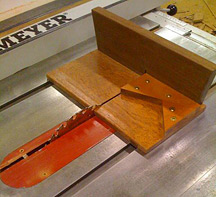
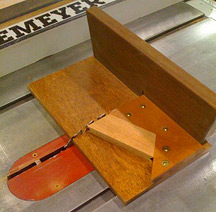
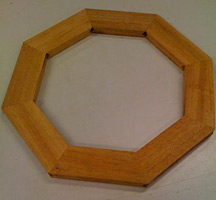
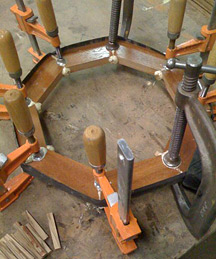
|